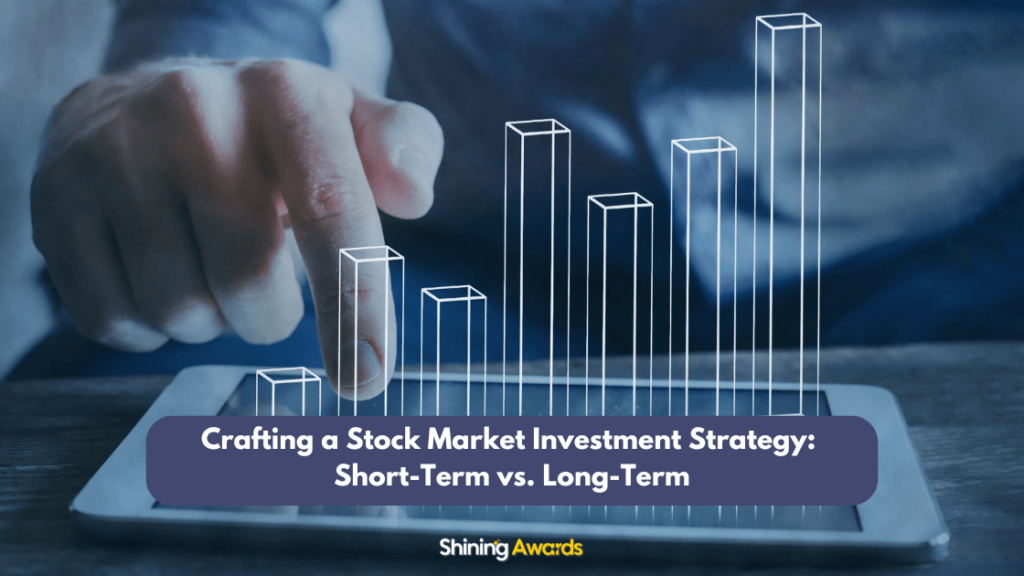Crafting a Stock Market Investment Strategy: Short-Term vs. Long-Term

Stock Market Investment Strategy – Delving into the dynamic realm of stock market investment, this article navigates the complexities of crafting a strategic approach. From short-term tactics promising quick gains to long-term strategies emphasizing steady growth, we explore the nuances and trade-offs. Join us as we unveil the secrets of effective investment decision-making tailored towards achieving financial success.Additionally, if you want to know more about investments and firms, you may visit a reliable investment firm and create a free account.
Stock Market Investment Strategy

Understanding Short-Term Investment Strategies
Short-term investment strategies revolve around capitalizing on immediate market fluctuations, aiming for quick gains within a brief timeframe. These strategies, including day trading, swing trading, and scalping, require a keen eye for market movements and rapid decision-making. Unlike long-term investments, which prioritize steady growth over time, short-term strategies focus on seizing fleeting opportunities in the market.
Day trading involves buying and selling financial instruments within the same trading day, aiming to profit from intraday price movements. Traders closely monitor market trends, news, and technical indicators to make split-second trading decisions. While day trading offers the potential for high returns, it also carries significant risks due to its short-term nature and market volatility.
Swing trading entails holding positions for a few days to several weeks to capitalize on short-to-medium-term price swings. Traders analyze chart patterns, support and resistance levels, and momentum indicators to identify potential entry and exit points. Although swing trading requires less time commitment compared to day trading, it still demands meticulous analysis and risk management.
Scalping is a high-frequency trading strategy focused on profiting from small price movements. Scalpers execute numerous trades within a short time frame, aiming to accumulate small profits per trade. This strategy requires lightning-fast execution, strict discipline, and advanced trading technology to capitalize on fleeting opportunities in the market.
The Long-Term Investment Horizon
Contrary to short-term strategies, long-term investment focuses on building wealth gradually over an extended period. Investors adopt a patient approach, emphasizing fundamental analysis, strategic asset allocation, and portfolio diversification to achieve their financial goals. Unlike short-term traders who thrive on market fluctuations, long-term investors prioritize steady growth and income generation.
Long-term investment strategies typically involve buying and holding assets such as stocks, bonds, and real estate with the expectation of capital appreciation and income generation over several years or decades. Investors focus on the underlying fundamentals of the assets, including earnings growth, dividend payments, and economic prospects, rather than short-term price fluctuations.
Strategic asset allocation plays a pivotal role in long-term investment success, as it involves diversifying investments across different asset classes to mitigate risk and maximize returns. Investors allocate their capital towards a mix of equities, fixed income securities, and alternative investments based on their risk tolerance, time horizon, and financial objectives.
Fundamental analysis serves as a cornerstone of long-term investment decision-making, allowing investors to assess the intrinsic value of assets based on their underlying financial metrics, competitive advantages, and industry trends. By identifying undervalued assets with strong growth potential, investors can capitalize on long-term market inefficiencies and generate sustainable returns over time.
Comparing Short-Term and Long-Term Investment Strategies
When comparing short-term and long-term investment strategies, investors must weigh the trade-offs between immediate gains and sustained growth. While short-term strategies offer the potential for quick profits, they come with higher risks and transaction costs. In contrast, long-term strategies prioritize steady accumulation of wealth through disciplined investing and strategic asset allocation.
Short-term investors often rely on technical analysis, market sentiment, and short-term trends to make trading decisions. They capitalize on short-lived market inefficiencies and exploit price fluctuations for quick gains. However, short-term trading requires constant monitoring, rapid decision-making, and psychological resilience to navigate market volatility successfully.
On the other hand, long-term investors focus on fundamental analysis, economic trends, and the intrinsic value of assets to make investment decisions. They adopt a buy-and-hold approach, emphasizing patience, discipline, and a long-term perspective. While long-term investing may involve periods of market downturns and volatility, investors benefit from compounding returns and the power of time in building wealth.
When evaluating short-term and long-term strategies, investors should consider their risk tolerance, investment goals, and time horizon. Short-term strategies may be suitable for active traders seeking quick profits, while long-term strategies are ideal for investors looking to build wealth steadily over time. Ultimately, the choice between short-term and long-term investment strategies depends on individual preferences, financial objectives, and risk appetite.
To make an informed decision, investors should conduct thorough research, seek advice from financial experts, and consider the pros and cons of each approach. By aligning their investment strategy with their financial goals and risk tolerance, investors can navigate the complexities of the stock market and achieve long-term success.
Conclusion
In conclusion, this exploration of short-term versus long-term investment strategies sheds light on the multifaceted nature of stock market investing. By understanding the intricacies of each approach and considering individual goals and risk tolerance, investors can unlock the secrets to building a robust investment portfolio. Remember, seeking advice from financial experts and conducting meticulous research are key to navigating the ever-changing landscape of the stock market.
